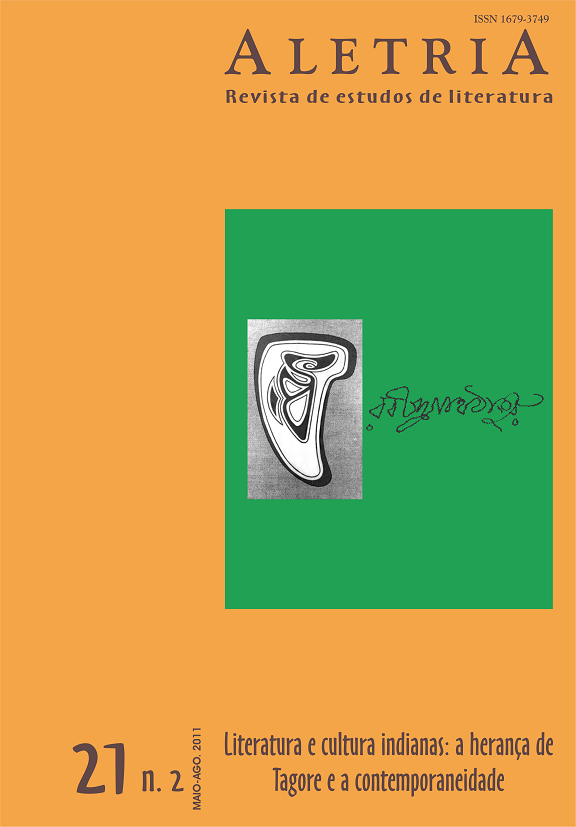Identidades de gênero em O Deus das Pequenas Coisas, de Arundhati Roy
DOI:
https://doi.org/10.17851/2317-2096.21.2.95-111Palabras clave:
gênero, fluidez, literatura IndianResumen
Este artigo analisa o romance O deus das pequenas coisas, de Arundhati Roy, em seus questionamentos de gênero. A obra contesta caracterizações unitárias e cristalizadas de gênero e apresenta representações mais complexas e fluidas. Os personagens são frequentemente vinculados a imagens de fluidos, questionando características tradicionalmente relacionadas ao feminino ou ao masculino e valorizando a complexidade de suas caracterizações. A narrativa reformula as possibilidades de representações de gênero, interroga qualquer noção de uma identidade estável e constrói imagens que são desestabilizadoras.
Descargas
Referencias
ADHIKARI, M. Power Politics in The God of Small Things. In: DHAWAN, R. K. (Ed.). Arundhati Roy: The Novelist Extraordinary. Nova Delhi: Prestige, 1999. p. 41-48.
ALMEIDA, Sandra Regina Goulart. Corpos fronteiriços em deslocamentos culturais: a política do corpo em O deus das pequenas coisas. In: DUARTE, Constância; GAZZOLA, Ana Lúcia; ALMEIDA, Sandra (Org.). Gênero e representação em literaturas de língua inglesa. Belo Horizonte: Editora da UFMG, 2002. p. 92-98.
ANG, Ien, HERMES, Joke. Gender and/in Media Consumption. In: CURRAN, James, GUREVITCH, Michael (Org.). Mass Media and Society. Londres: Edward Arnold, 1991. p. 317-338.
BAUMAN, Zygmunt. Modernidade líquida. Trad. Plínio Dentzien. São Paulo: Jorge Zahar Editor, 2001.
BHABHA, Homi. A outra questão: o estereótipo, a discriminação e o discurso do colonialismo. In: ______. O local da cultura. Trad. Myriam Ávila, Eliana Reis e Gláucia Gonçalves. Belo Horizonte: Editora UFMG, 2007. p. 105-138.
BUTLER, Judith. Problemas de gênero. Trad. Renato Aguiar. São Paulo: Civilização Brasileira, 2003.
CHANDA, Tirhankar. Sexual/Textual Strategies in The God of Small Things. Commonwealth Essays and Studies, Dijon, v. 20, n. 1, p. 38-44, 1997.
D’SOUZA, Florence. Silences and Ellipses in The God of Small Things. In: DURIX, Carole, DURIX, Jean Pierre (Org.). Reading Arundhati Roy’s The God of Small Things. Dijon: Edições Universitárias de Dijon, 2002. p. 111-124.
DUBE, Leela. Caste and Women. In: SRINIVAS, M. N. (Ed.). Caste: Its Twentieth-Century Avatar. Nova Delhi: Viking, Penguin India, 1996. p. 112-119.
JEHLEN, Myra. Gender. In: LENTRICCHIA, Frank; MCLAUGHLIN, Thomas (Ed.). Critical Terms for Literary Study. Chicago: Universidade de Chicago, 1991. p. 263-273.
KHUSHU-LAHIRI, Rajyashree. Broken Laws, Shattered Lives: A Study of The God of Small Things. In: DHAWAN, R. K. (Ed.). Arundhati Roy: The Novelist Extraordinary. New Delhi: Prestige, 1999. p. 112-119.
KUMAR, Radha. The History of Doing. Nova Iorque: WW Norton, 1993.
LAURETIS, Teresa de. The Technology of Gender. In: RIVKIN, Julie, RYAN, Michael (Ed.). Literary Theory: An Anthology. Oxford: Blackwell, 2000. p. 713-721.
MAFFESOLI, Michel. Sobre o nomadismo: vagabundagens pós-modernas. Trad. Marcos de Castro. Rio de Janeiro e São Paulo: Record, 2001.
MULLANEY, Julie. Arundhati Roy’s The God of Small Things. Nova Iorque e Londres: Continuum, 2002.
NOLASCO, Sócrates. De Tarzan a Homer Simpson: banalização e violência masculina em sociedades contemporâneas ocidentais. Rio de Janeiro: Rocco, 2001.
ROY, Arundhati. O deus das pequenas coisas. Trad. José Rubens Siqueira. São Paulo: Companhia das Letras, 1997.
ROY, Arundhati. Power Politics. Massachusetts: Cambridge UP, 2001.
RUBIN, Gayle. The Traffic in Women: Notes on the Political Economy of Sex. In: REITER, Rayna (Org.). Toward an Anthropology of Women. Nova Iorque: Monthly Review Press, 1975. p. 157-210.
TICKELL, Alex. Arundhati Roy’s The God of Small Things. Londres e Nova Iorque: Routledge, 2007.
Descargas
Publicado
Número
Sección
Licencia
Derechos de autor 2011 Marcelo Augusto Nery Médes (Autor)

Esta obra está bajo una licencia internacional Creative Commons Atribución 4.0.
Authors who publish with this journal agree to the following terms:Authors retain copyright and grant the journal right of first publication with the work simultaneously licensed under a Creative Commons Attribution Non-Commercial No Derivatives License that allows others to share the work with an acknowledgement of the work's authorship and initial publication in this journal.Authors are able to enter into separate, additional contractual arrangements for the non-exclusive distribution of the journal's published version of the work (e.g., post it to an institutional repository or publish it in a book), with an acknowledgement of its initial publication in this journal.Authors are permitted and encouraged to post their work online (e.g., in institutional repositories or on their website) prior to and during the submission process, as it can lead to productive exchanges, as well as earlier and greater citation of published work (See The Effect of Open Access).









